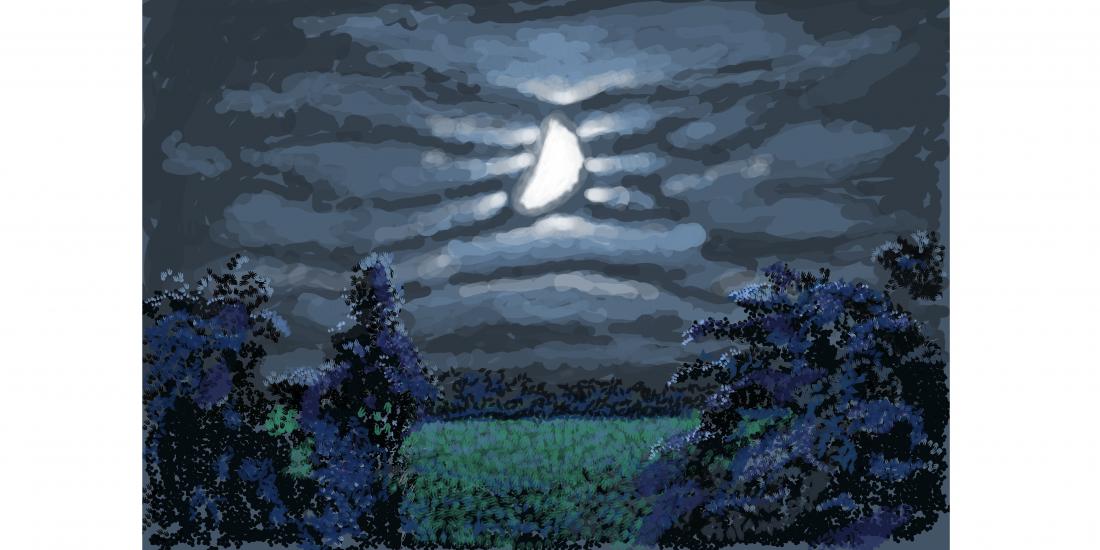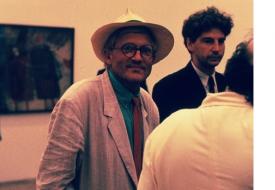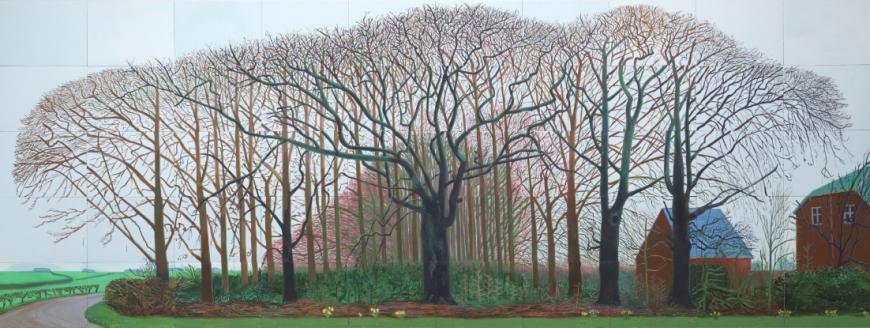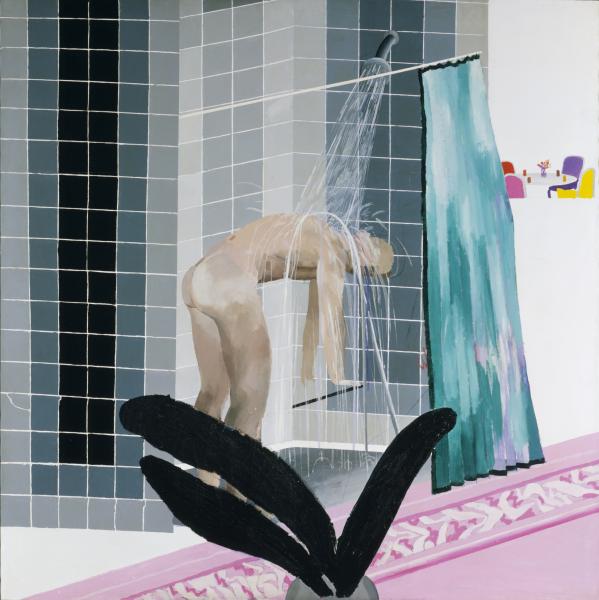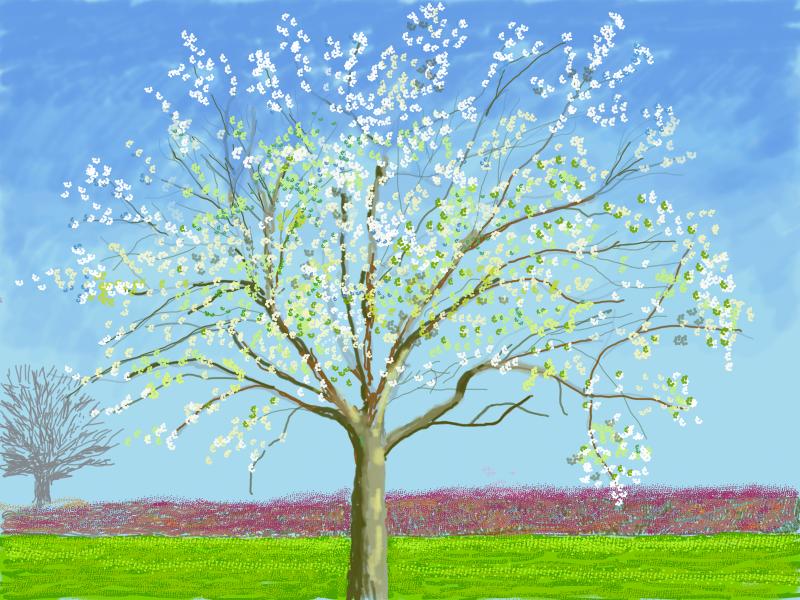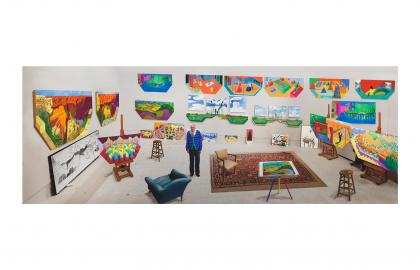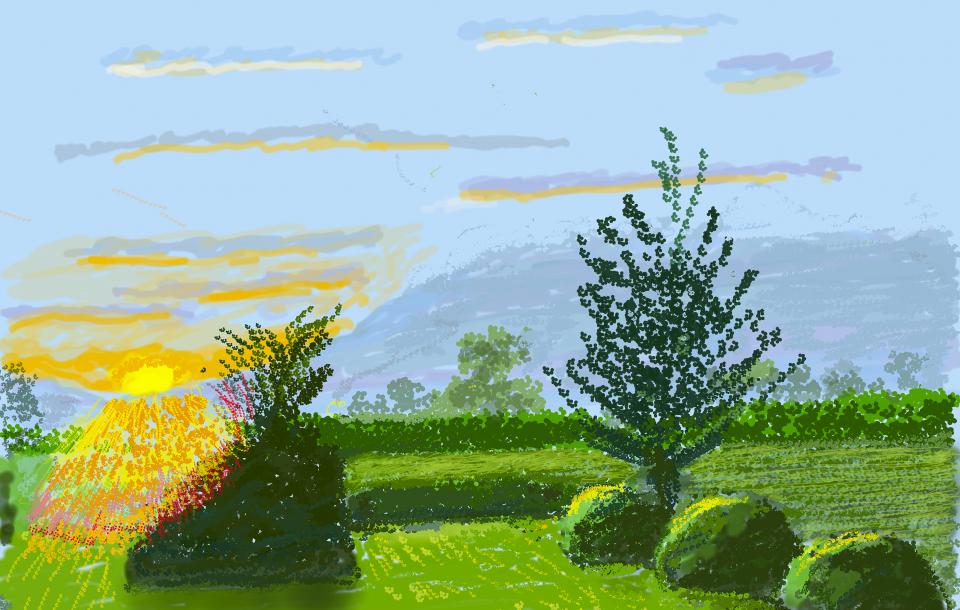
Versatile and innovative
Did you think that David Hockney was just a painter? In the same way that he lets his artistic imagination run free, he’s also active in a range of different media. He is a photographer, a draughtsman, and a set and costume designer for opera. He doesn’t shy away from experimentation: he started using Polaroid photography in the early 1980s. Polaroids may seem retro to young eyes today, but back then they represented the cutting edge of technology. In the The Arrival of Spring, Normandy, 2020 section of the Bozar double exhibition, you will discover the most recent example of Hockney’s constant drive to experiment. During the first lockdown, he left his home in Normandy to record the springtime on his iPad. Each of these pieces is an ode to life that captures the beauty of nature.
“I think I’m greedy, but I’m not greedy for money – I think that can be a burden – I’m greedy for an exciting life. I want it to be exciting all the time, and I get it, actually. On the other hand, I can find excitement, I admit, in raindrops falling on a puddle and a lot of people wouldn’t. I intend to have it exciting until the day I fall over.”
A Brit with Californian taste
Hockney grew up in Yorkshire in the North of England and studied at the Royal College of Art in London. After graduating in 1962, he set off for California. The American ‘West Coast lifestyle’ of swimming pools and colourful houses appealed to him enormously and became one of the main inspirations in his work. Hockney developed the habit of shuttling back and forth between Europe and America; two different lifestyles and landscapes. This split personality comes forth in his work. The grey sky in the vast Bigger Trees near Warter Or/ou Peinture Sur le Motif Pour Le Nouvel Age Post-Photographique is in sharp contrast with his colourful Californian works. But that’s the strength of Hockney: to find beauty anywhere and in any situation - in the most varied ways.

Flesh and blood
What is so unusual about Hockney’s portraits is their extremely personal tone. He never paints portraits on commission. Everything in his work is close to his actual life: from his home in Los Angeles to his back garden in Normandy, and his friends, family and loved ones. When you look at a work by Hockney, you step into his world, whether you want to or not. One of his most famous double portraits is that of Mr and Mrs Clark and their cat, Percy. Hockney was the best man at the couple’s wedding, and he depicts them in the most intimate room in their flat in Notting Hill: the bedroom. You almost feel like kicking off your shoes and wriggling your toes in the carpet.
“Americans take showers all the time ... For an artist the interest of showers is obvious: the whole body is always in view and in movement, usually gracefully, as the bather is caressing his own body. There is also a three-hundred-year tradition of the bather as a subject in painting. Beverly Hills houses seemed full of showers of all shapes and sizes ... They all seemed to me to have elements of luxury ... very un-English that!”
Subtle yet daring
Homosexuality was only partially legalised in 1967 in the United Kingdom, where Hockney – a homosexual himself - was active as an artist in the 1960s. He saw this oppression not as a threat, but as a challenge to undermine, to shock, and to unsettle heteronormative structures. And where better to do that than in art, where he began to allude to his own sexuality and to depict queer scenes? Later, when Hockney lived in California and taught at university, he met Peter Schlesinger, a student eleven years his junior. Schlesinger became not only his lover, but also one of his greatest muses. In LA, Hockney painted men next to and in swimming pools, in showers and so on.
“They want to be ordinary – they want to fit in. Well I don’t care about that. I don’t care about fitting in. Everywhere is so conservative.”
Cheeky and stubborn
Hockney knows what he wants, and always has. At the age of eleven, he wanted to be an artist, at twenty, he refused to do his military service, and in middle age, he turned down a knighthood. This stubbornness also permeates his work. When he was a student in London, Abstract Expressionism reigned supreme. Figuration was a fading glory, but not for Hockney. He quickly started to reconcile and blend abstract and figurative art in his portraits, landscapes and interiors. In 1979, he complained in The Observer newspaper about the Director of the Tate, Sir Norman Reid, who, according to Hockney, was buying too much abstract art. “This is just totally absurd. People have been painting faces, for example, for 5,000 years — and for good reason.”
You can visit the double exhibition David Hockney: Works from the Tate Collection, 1954-2017 and David Hockney: the Arrival of Spring, Normandy, 2020 from 8 October to 23 January 2022 at Bozar. Book your tickets now on our website.
